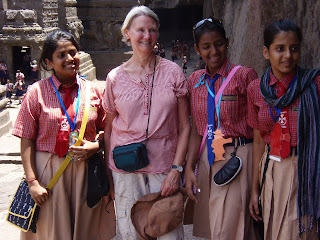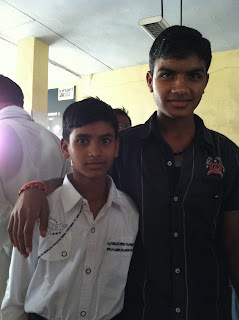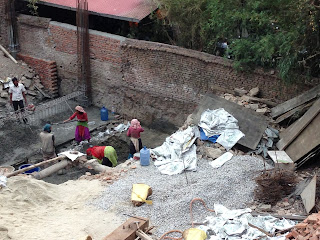The fancy doorman at our hotel helped us into the car for the 100km ride to Ajanta, the second group of temples and monasteries carved into hill sides in a horseshoe shape around a river valley.
. When we got to the entrance we were offered a ride up for only 800 rupees. That seemed like cruel and unusual punishment for the men who would have carried us so we hiked up the steps to the caves.
There are 27 caves in all, some date from the 2nd-1st century BC while others are from the 5th century AD.
The carved stone architectural elements rival Ellora but these have the added richness of murals painted on plaster.
The reason they have survived as well as they have is that the caves were abandoned in the 8th century and were not rediscovered until 1819 when a British officer on a a tiger hunt. It seems the caves were a favorite shelter for tigers. There is damage from humidity and water but no vandalism or destruction by invaders as we saw at other sites. Tourists take of their shoes, there is no flash photography and they run dehumidifiers and air filters inside the caves.
The murals are amazing in their richness of color (natural pigments from plants and ground minerals), detailed storytelling and facial expressions and the record of daily life they show us. Our guide pointed out many different facial types (Mongolian, Greek, various Indian types and skin tones) and the voluptuous female forms. This dark prince and fair lady (light skin color) on a bed drinking wine are even done in perspective. When did perspective show up in Western Art? Not until the Renaissance 800 years later.
Ali, our guide, called this portrait of Buddha the "Mona Lisa" of Ajanta. His facial expression of compassion is delicate and evocative. Just as the stained glass windows in gothic cathedrals conveyed teachings of the Bible to the congregants, these murals were meant to instruct followers and possible converts about the life of the Buddha and his teachings. My photos don't really do them justice so Google-up if you are interested in them.
This apsara or celestial maiden is adoring the buddha. Note the details of jewelry and headdress.
The ceilings are decorated with a quilt work of images both human figures and botanicals. There are also intricate mandalas. I'm not quite sure what these two men are doing, but the detailed expression and straining muscles are representative of the artistic skill displayed all over these caves.
The 2nd century BC also have paintings but the figure of the Buddha is not represented as a god. The main focus of the temple is a stupa, not a life-like statue.
The columns show influences of Greek and Egyptian architecture and are also highly ornamented with carvings.
A few of the caves date from the 7th century. This one contains a 23 foot-long reclining Buddha along with other smaller images of him circling the rest of the temple. In this pose (similar to temples we saw in Thailand and Sri Lanka, the Buddha has reached the state of Nirvana and dies in perfect peace and bliss.
Inside the caves it is cool and humidity controlled but outside it was 90 degrees so after couple hours we were ready to get to the AC van and head back. We stopped along the way for a very light lunch at a road sde restaurant with a beautiful flowering tree and the ubiquitous plastic lawn chairs. Eva got accosted again by a family who wanted to have a picture with her.
Our guide Ali's grandparents were in the "untouchable" class. We think that his explanation of why so many Hindus converted to Buddhism, Jainism and Islam was very plausible. If your religion tells you that your future, your job class, porridge prospects and much more are determined at birth and you are labeled "untouchable" , you might seek another religion. Although it is outlawed, the cast system still has profound effects in the Indian culture, much like the way blacks were freed at the time of the civil war but remained slaves in many ways due to the culture of the South.
On the other hand, we have seen many examples of how the Indian culture absorbed influences from China, Greece, Persia, Britain and many other sources. A good emblem of how these influences have been absorbed can be seen in this statue of Christ in a Jesuit school, Christ seated as Buddha or the Buddha with Christ's face and hair?


















































